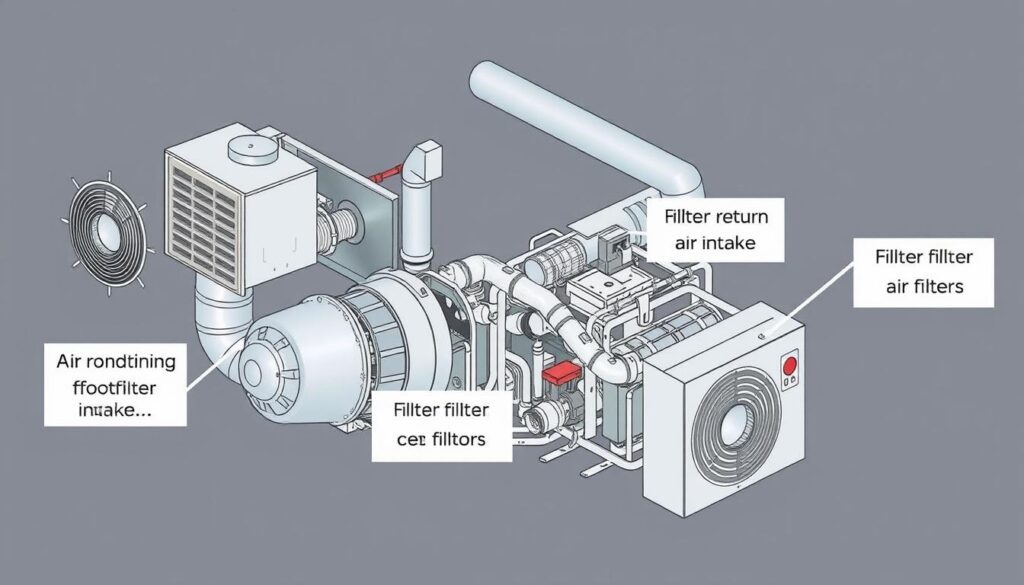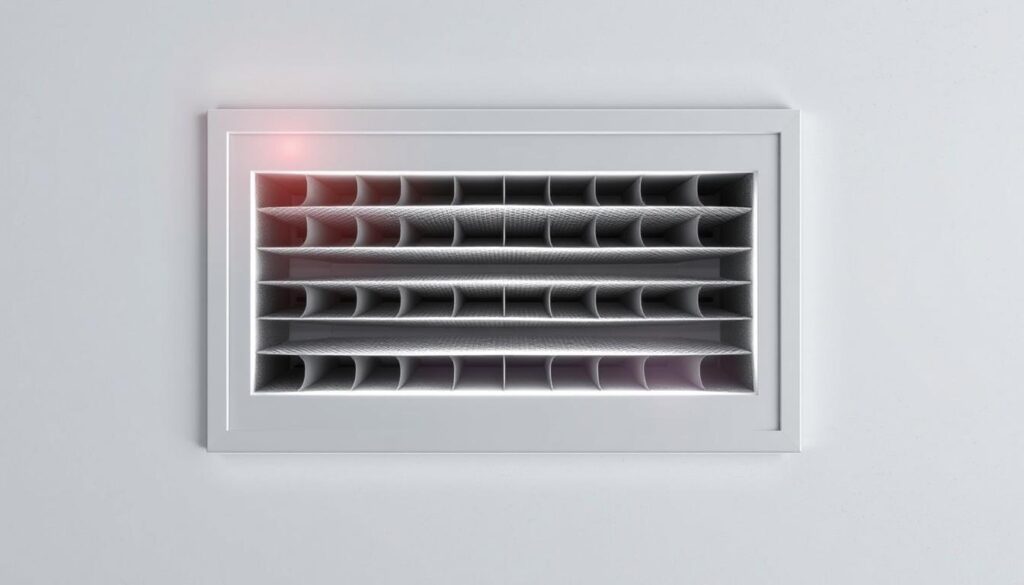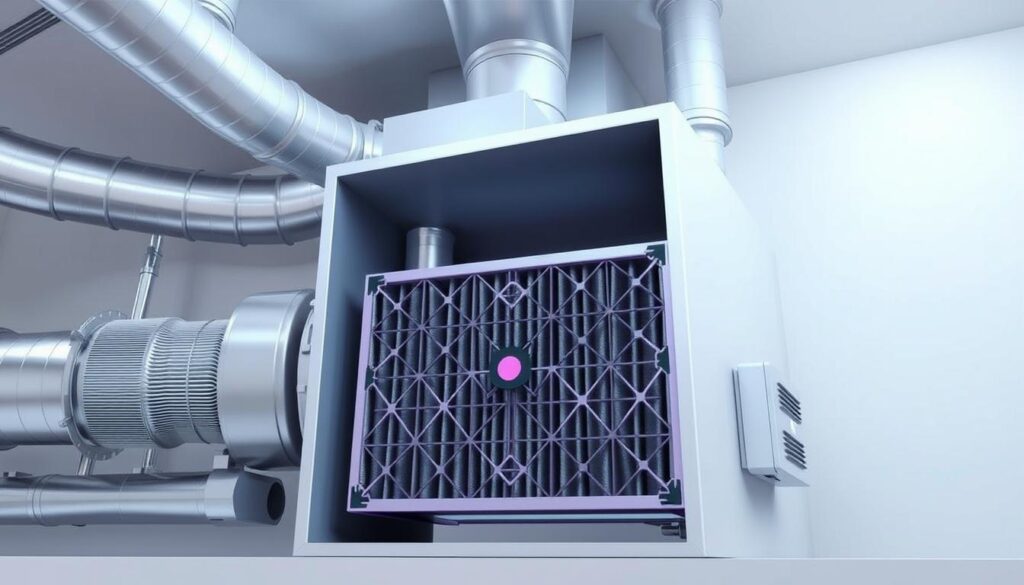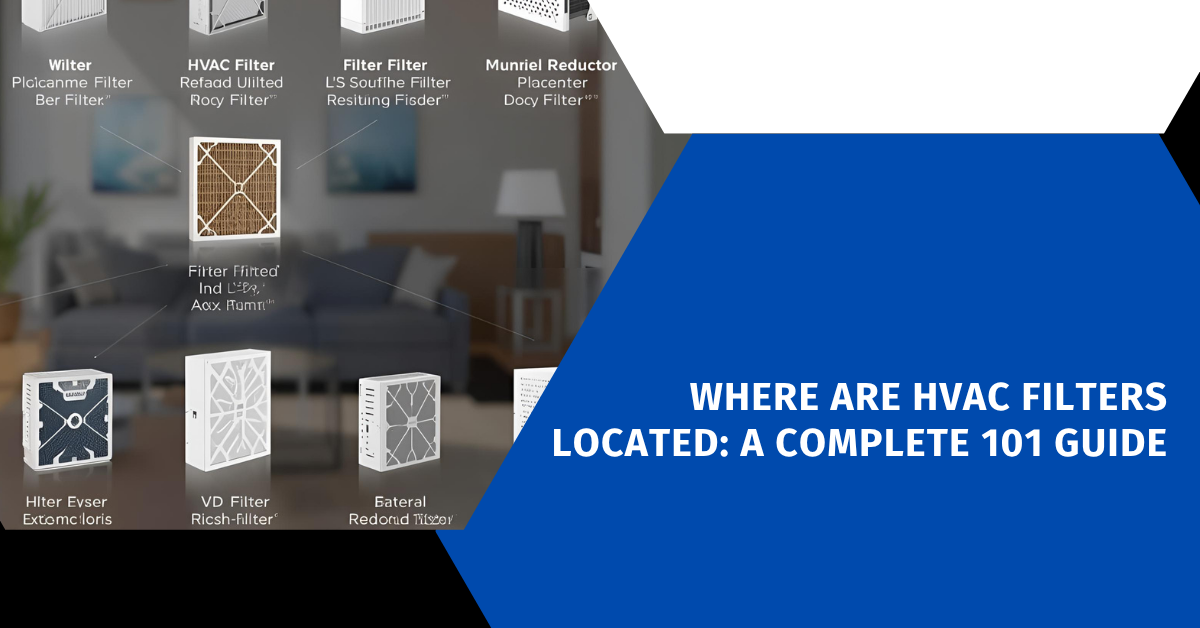Affiliate Disclosure
HVAC Guide Guys is a participant in the Amazon Services LLC Associates Program, an affiliate advertising program designed to provide a means for sites to earn advertising fees by advertising and linking to Amazon.
Where Are HVAC Filters Located? Ever noticed how some homes have fresher air while others feel stuffy? The answer might be in your HVAC filter location.

Finding your HVAC filters is key to better air and a healthier home. The Environmental Protection Agency says checking filters often is essential for a clean indoor space.
Replacing HVAC filters is simple once you know the basics. Each home’s setup has its own filter spot. With the right info, you can keep your system working well.
Key Takeaways
- HVAC filters are critical for maintaining indoor air quality
- Filter locations vary depending on your home’s HVAC system type
- Regular filter checks can improve system performance
- Understanding filter placement helps with easier maintenance
- Proper filter location impacts overall system efficiency
Table of Contents
Understanding the Importance of HVAC Filter Location
Your HVAC system’s performance and air quality depend on the right furnace filter location and air conditioning filter placement. Knowing where these filters are can greatly improve your home’s comfort and your system’s efficiency.
Filters do more than catch dust. They protect your home’s air quality and your HVAC system’s health. When placed correctly, they catch harmful particles and prevent damage to your heating and cooling equipment.
Impact on Air Quality and System Performance
Proper filter placement greatly affects your indoor air quality. A well-placed filter can:
- Capture tiny dust particles
- Reduce allergens and pollutants
- Stop debris from reaching important system parts
“A clean filter is your HVAC system’s best protection against unnecessary wear and tear.” – HVAC Maintenance Experts
Why Filter Placement Matters for Efficiency
The air conditioning filter’s location is key to system efficiency. Filters in return air ducts or before the air handler remove particles best. This ensures clean air circulates through your home.
Role in System Protection and Maintenance
Choosing the right furnace filter location helps avoid:
- Premature system wear
- Unexpected breakdowns
- Higher energy use
Understanding your HVAC filter’s location can save you a lot of money and maintenance trouble in the long run.
Explore Our HVAC Shop
Looking for top-rated HVAC tools, parts, and accessories? Visit our shop and find the perfect solution for your needs.
Visit the ShopCommon Types of HVAC Systems and Filter Placements
It’s important to know about different HVAC systems for good central air filter position and hvac system maintenance. Each system has its own features that affect where filters go and how they work.
Residential HVAC systems usually fall into three main types:
- Central Air Conditioning Systems: These have an indoor air handler and an outdoor condenser unit. Filters are often in the return air duct or blower compartment.
- Furnace Systems: These systems heat and cool and have filters in the furnace unit or a filter slot.
- Heat Pump Systems: They heat and cool and have filters in similar spots to central air units.
The design of your HVAC system decides the best filter spot. Some systems make it easy to find filters, while others need more looking. Knowing your system helps with maintenance and keeps the air clean.
Pro Tip: Always check your system’s user manual for precise filter location guidance.
It’s key to check and replace filters regularly for best system performance and air quality. Different systems need different maintenance, so learn about your specific HVAC setup.
Where Are HVAC Filters Located in Different Home Setups
Finding your return air vent filter is key to keeping your HVAC system running well. Every home is different, which affects where air filters go. Knowing this helps you take better care of your heating and cooling system.
When looking for hvac air filters, you might find them in several spots. They often sit in return air ducts, blower compartments, or on walls, ceilings, and floors.
Return Air Duct Locations
Return air vents usually have filters in central spots of your home. These vents pull air back into the system for filtering. You’ll find them:
- Near hallway ceilings
- In main living spaces
- Adjacent to stairways
Blower Compartment Placements
The blower compartment is another important spot for filters. It’s inside your furnace or air handler, making it easy to get to the filters.
| Location Type | Typical Access Method | Difficulty Level |
|---|---|---|
| Furnace Interior | Remove front panel | Easy |
| Air Handler | Slide-out filter slot | Moderate |
Wall, Ceiling, and Floor Installations
Some homes have filters in less common places. To find hvac air filters, check:
- Wall-mounted return air grilles
- Ceiling-recessed filter housings
- Floor-level return air vents
Pro tip: Always check your HVAC system’s manual for exact filter location guidance for your home.
Explore Our HVAC Shop
Looking for top-rated HVAC tools, parts, and accessories? Visit our shop and find the perfect solution for your needs.
Visit the ShopIdentifying Filter Locations in Horizontal HVAC Units
Horizontal HVAC units are tricky to find air filter locations for. They are often in attics, big basements, or garages. Knowing where to find the filters is key for clean air and system health.
For horizontal units, look at the air return side. These systems have airflow moving sideways, unlike vertical ones.
- Check the side panels of the HVAC unit
- Look for a removable access panel
- Inspect areas near the blower compartment
The filter’s spot in horizontal HVAC units is usually near the return air duct. Here’s a quick guide to find your filter:
| Unit Location | Typical Filter Access |
|---|---|
| Attic Installation | Side access panel |
| Basement Setup | Bottom or side compartment |
| Garage Placement | Removable front or side panel |
Pro tip: Always check your unit’s manual for the exact filter spot. If unsure, use a flashlight to look for access points. Remember to turn off your HVAC before finding or changing the filter.
Locating Filters in Vertical HVAC Systems
Vertical HVAC systems are tricky to find and replace filters in. They are often in tight spots like basements, utility rooms, attics, and crawl spaces. Knowing where to find these filters can save you time and avoid maintenance problems.
Vertical HVAC units have filters in different spots than horizontal ones. Knowing how to replace them right keeps your system running well and air clean.
Basement and Utility Room Layouts
In basements and utility rooms, filters are usually found in these places:
- Near the bottom of the unit
- Inside a dedicated filter compartment
- Behind an access panel
Attic and Crawl Space Considerations
Attic and crawl space systems need careful checking. You should:
- Find the access panel with care
- Look for side or bottom filter slots
- Use good lighting for inspection
Finding Access Panel Locations
To find your filter, look for these spots:
- Metal clips or latches on the side of the unit
- Removable panels with simple screw attachments
- Color-coded or labeled access areas
Pro tip: Always check your HVAC system’s manual. It will have the best guide for finding and replacing filters for your model.
Return Air Grill Filter Placement Guide

Finding the best spot for your return air vent filter can really boost your home’s air quality and HVAC system. Many homes have more than one return air grill, each with its own filter. Knowing how to place these filters is key to keeping your indoor air clean and healthy.
Return air grills are found in important spots around your home. These include:
- Living rooms
- Hallways
- Bedrooms
- Central corridors
Each return air vent filter is vital in catching dust, allergens, and other particles. This stops them from going through your HVAC system. By placing them strategically, you get cleaner air in each room.
| Location Type | Filter Accessibility | Maintenance Frequency |
|---|---|---|
| Wall-mounted Grill | Easy | Every 1-3 months |
| Ceiling Grill | Moderate | Every 2-4 months |
| Floor-level Grill | Challenging | Every 3-6 months |
Managing multiple return air vent filters needs a plan. Make a schedule for checking and replacing them. Pro tip: Mark filter replacement dates directly on each grill to track maintenance efficiently.
Regular filter changes prevent system strain and maintain optimal air quality in every room of your home.
Explore Our HVAC Shop
Looking for top-rated HVAC tools, parts, and accessories? Visit our shop and find the perfect solution for your needs.
Visit the ShopFinding Filters in Central Air Handler Units
It can be hard to find the central air filter for many homeowners. The air filter is key for clean indoor air and a working HVAC system. Knowing where to find hvac air filters in central air handler units helps with regular upkeep.
Central air handler units have different filter spots. Knowing where to look saves time and avoids frustration when replacing filters.
Front Access Panel Locations
Most central air handlers have a front panel for easy filter change. These panels are made for simple removal and usually have:
- Sliding or hinged panel designs
- Clearly marked filter compartments
- Simple latch or screw mechanisms
Side and Bottom Filter Slots
Some HVAC systems have filters in spots other than the front. You might find slots on the side or bottom, which are also easy to access for maintenance.
- Side slots often run parallel to the unit
- Bottom slots may require slight bending or careful positioning
- Check your unit’s specific design for precise location
Filter Housing Identification
Finding the right filter housing is key for correct replacement. Look for these signs:
- Size markings on the current filter
- Rectangular or square-shaped compartments
- Arrows showing airflow direction
Pro tip: Always measure your current filter or check your HVAC system’s manual to pick the right replacement filter size and type.
Furnace Filter Location Specifics

Knowing where your furnace filter is is key for keeping your HVAC system running well. Most home furnaces have their filters in the blower compartment. This area is vital for air cleaning and system performance.
There are a few main places you might find your furnace filter:
- Inside the blower compartment
- Behind a return air grille
- In a dedicated filter cabinet
- Near the air handler unit
The exact spot for your furnace filter can differ based on your home’s heating setup. Some systems have filters in front, while others need you to open side or bottom panels.
“Knowing your furnace filter location is the first step in maintaining optimal indoor air quality and system efficiency.”
To find your furnace filter, look for these spots:
- Check near the return air duct
- Inspect the blower compartment door
- Look for removable panels on your furnace
- Examine the air handler unit
| Filter Location | Accessibility | Maintenance Difficulty |
|---|---|---|
| Blower Compartment | Easy | Low |
| Return Air Grille | Moderate | Medium |
| Side Panel | Challenging | High |
Regularly checking your furnace filter’s location can stop problems and keep your HVAC system in top shape. Always refer to your system’s manual for exact filter placement advice.
Explore Our HVAC Shop
Looking for top-rated HVAC tools, parts, and accessories? Visit our shop and find the perfect solution for your needs.
Visit the ShopTips for Accessing Hard-to-Reach Filter Locations
Dealing with hard-to-reach home air filter locations can be tough for homeowners. Some HVAC units have filters in tight spots like attics, crawl spaces, or behind big appliances. With the right tools, you can make accessing these filters easier and keep your system running well.
Before you start, get the right tools and prepare well. Here are some useful tips:
- Use a telescoping ladder for high attic or ceiling filter placements
- Invest in a flashlight with a flexible neck for better visibility
- Keep a step stool near challenging home air filter locations
- Wear comfortable clothing that allows easy movement
When working in tight spaces, safety is key. Always turn off your HVAC system before attempting to access or replace filters. If a spot seems too hard or risky, get a professional HVAC technician to help.
Some people find smart ways to make filter access easier. They install external filter housings or create easy access panels. These changes make future maintenance simpler and keep your system running great.
Pro tip: Create a maintenance schedule that maps out all your home’s filter locations to streamline future replacements.
Remember, regular filter maintenance is key, no matter how hard it is to get to. Clean filters improve air quality, cut down energy use, and make your HVAC system last longer.
Conclusion
Knowing where HVAC filters are is key for good air quality and system performance. This guide has shown you how to find filters in different HVAC systems. You’ve learned about return air ducts, blower compartments, and wall installations.
Replacing HVAC filters regularly is essential for home upkeep. In places like Las Vegas, dust and particles are common. Knowing where your filters are helps keep the air clean.
Your HVAC system works hard to keep your home comfortable. Keeping filters clean ensures it runs well.
Get to know where your HVAC filters are. Whether they’re in the basement or attic, knowing their spot makes changing them easier. Change filters every 60-90 days, or more often if you have pets or allergies.
By knowing where filters are and changing them often, you’ll improve your home’s air. You’ll also save on energy and make your system last longer. Your effort in keeping filters clean is good for your home and family’s health.

